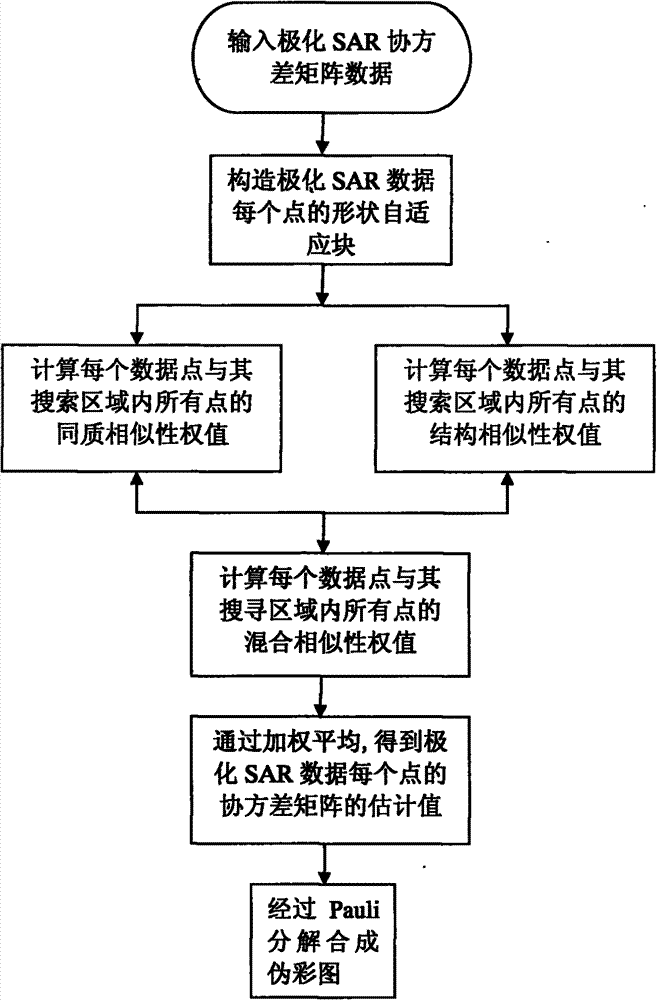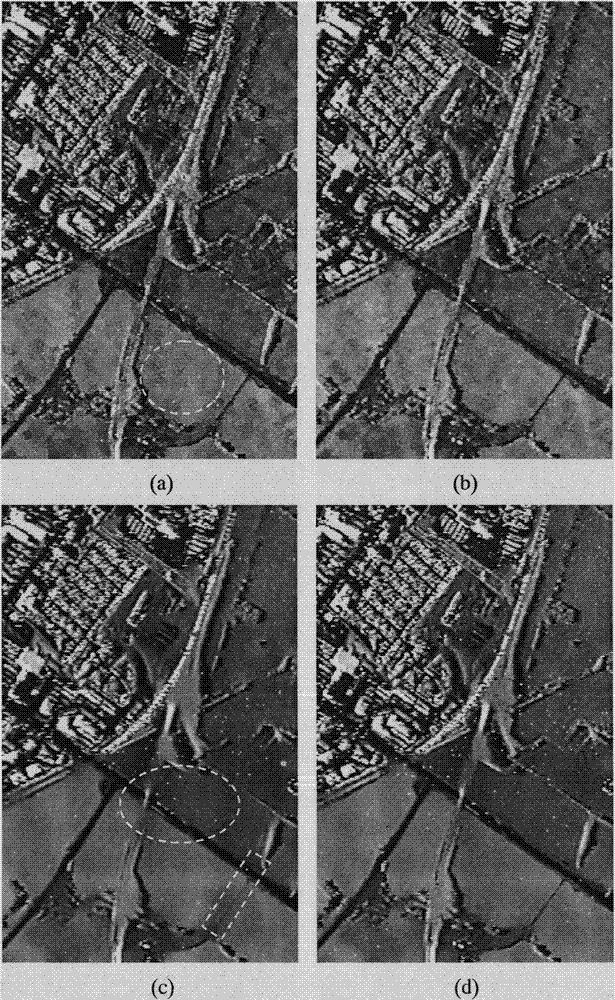Mixed block similarity-based polarized SAR (Synthetic Aperture Radar) image speckle reduction method
A technology of similarity and mixed blocks, which is applied in the field of image processing, can solve problems such as fuzzy image details, target detection, recognition and object classification, and less structural information, etc., to achieve the effect of smooth speckle noise
- Summary
- Abstract
- Description
- Claims
- Application Information
AI Technical Summary
Problems solved by technology
Method used
Image
Examples
Embodiment 1
[0047] The invention is a speckle reduction method for polarimetric SAR images based on mixed block similarity. In the process of speckle reduction, the polarimetric SAR image is the echo signal obtained by the polarimetric synthetic aperture radar system, which has very rich ground object information, and has important applications in target detection, recognition, classification and other aspects. However, since the polarimetric SAR image suffers from serious speckle noise interference, and these interferences are very unfavorable to the interpretation of the polarimetric SAR image, speckle suppression must be carried out. The polarimetric SAR image data that the present invention uses in experiment has two groups of real polarimetric SAR data obtained in different regions by different radar systems, and these data are provided by the European Space Agency; another group is synthesized by mathematical methods Polarimetric SAR data. The required experimental equipment of the...
Embodiment 2
[0082] The speckle reduction method for polarimetric SAR images based on the similarity of mixed blocks is the same as in Embodiment 1, referring to the attached figure 1 , where the structural similarity weight w in step (3) S (i,j) is the structural similarity distance d S (i, j) related, the structural similarity distance d S The calculation of (i, j) includes the following steps:
[0083] 3.1) Pseudo-color map synthesized by inputting polarimetric SAR covariance matrix data, if using figure 2 middle figure 2 (a) or figure 2 (b) or figure 2 (c) Either way, a search area with a size of N×N is taken out with a pixel point i to be estimated in the image as the center. In the experiment, the value of N is 15, that is, the size of the search area is 15×15.
[0084] 3.2) Take a block of M×M size centered on the pixel point i to be estimated, and take a block of M×M size centered on each pixel point j in the search area. Here, the value of the block size M can be any i...
Embodiment 3
[0092] The speckle reduction method for polarimetric SAR images based on mixed block similarity is the same as in Embodiment 1-2.
[0093] Effect of the present invention can further confirm by following experiment:
[0094] 1. Experimental conditions and content
[0095] Experimental conditions: The input data used in the experiment are: the polarization SAR covariance matrix data of the ten-view Ottawa area obtained by CONVAIR radar, the polarization SAR covariance matrix data of the four-view San Francisco area obtained by AIRSAR radar, and the Synthesized ten-view polarimetric SAR covariance matrix data. The pseudo-color images synthesized from the above data are as follows: figure 2 (a), figure 2 (b) and figure 2 (c) shown. figure 2 The number 1 in (a) indicates the homogeneous area where the speckle removal effect is to be evaluated. figure 2 Numbers 2 and 3 in (b) indicate the detail areas to be evaluated for speckle removal. In the experiment, various filte...
PUM
 Login to View More
Login to View More Abstract
Description
Claims
Application Information
 Login to View More
Login to View More - R&D
- Intellectual Property
- Life Sciences
- Materials
- Tech Scout
- Unparalleled Data Quality
- Higher Quality Content
- 60% Fewer Hallucinations
Browse by: Latest US Patents, China's latest patents, Technical Efficacy Thesaurus, Application Domain, Technology Topic, Popular Technical Reports.
© 2025 PatSnap. All rights reserved.Legal|Privacy policy|Modern Slavery Act Transparency Statement|Sitemap|About US| Contact US: help@patsnap.com



